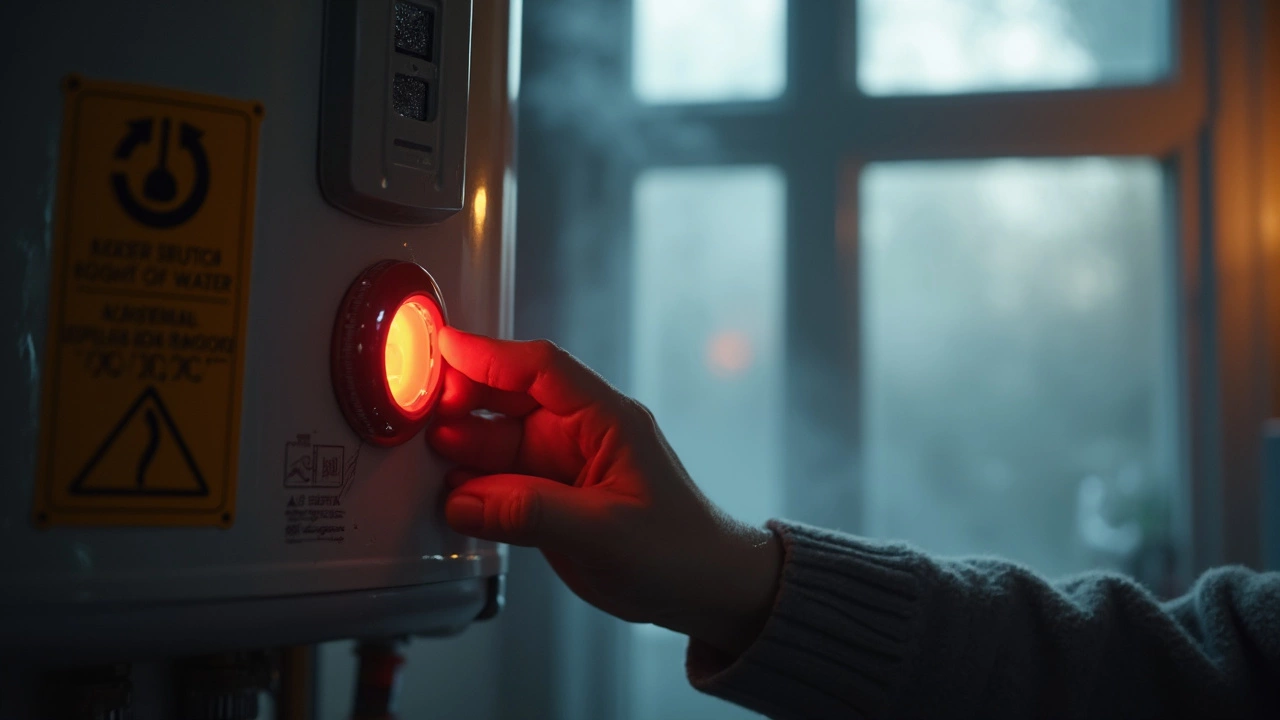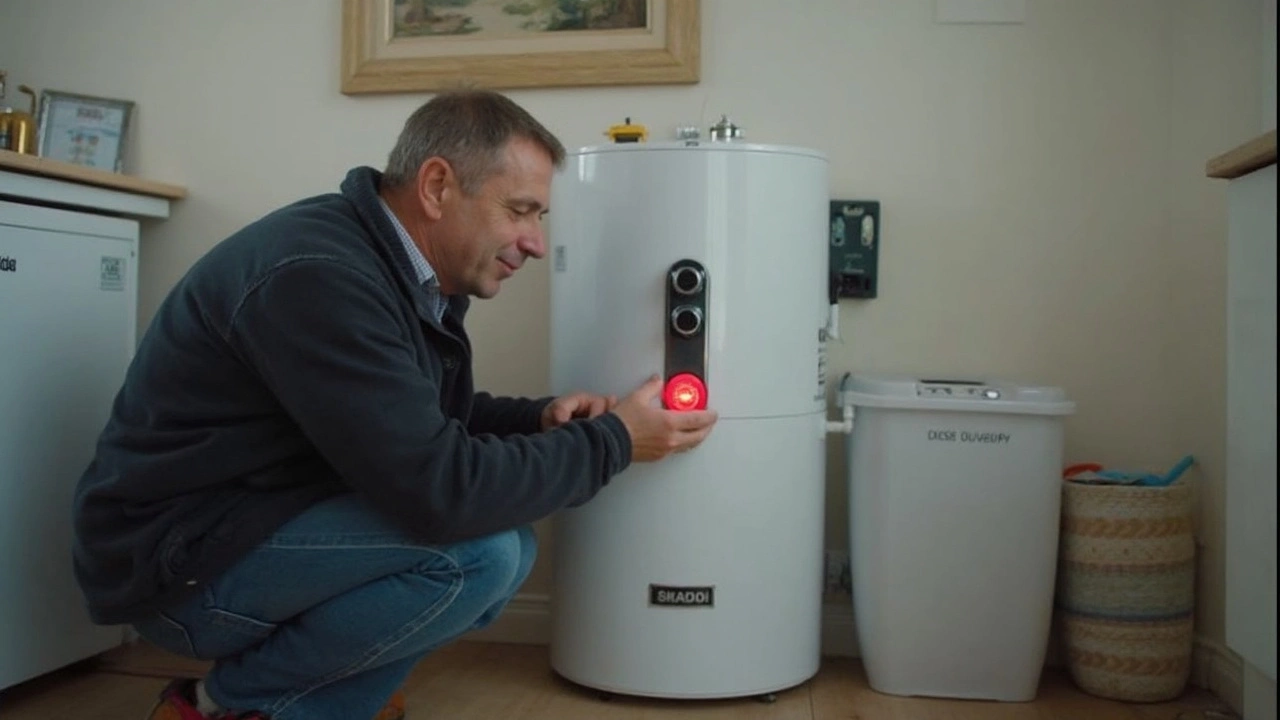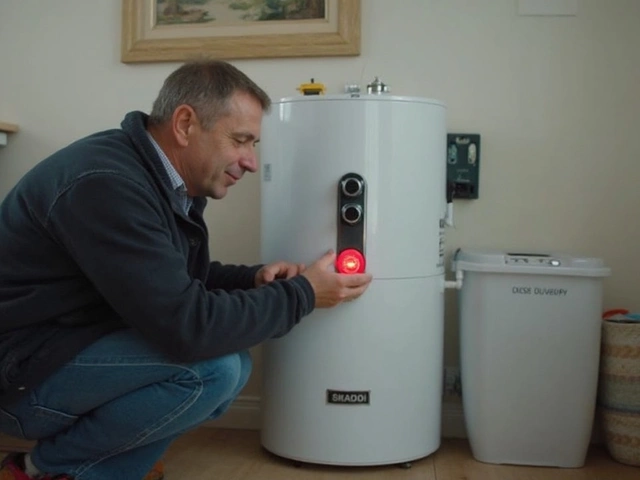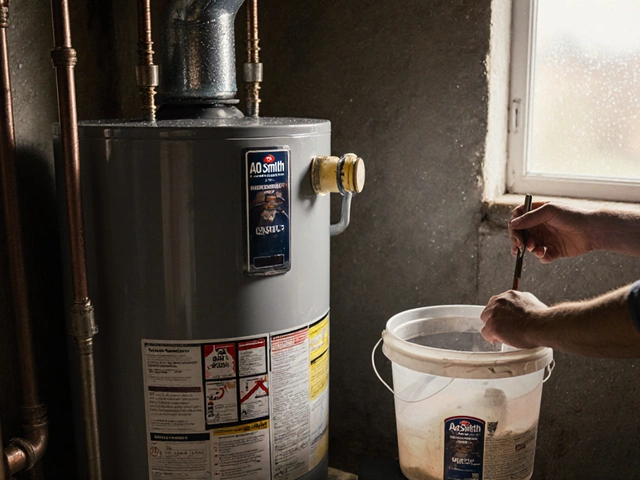If you’ve ever stood in a chilly shower cursing your water heater, you probably know about the little red reset button tucked behind a panel. Pushing it gets your hot water back—sometimes. But if you’re hitting that button way too often, there’s more going wrong than just a quick fix.
Think of your water heater’s reset button like the circuit breaker in your fuse box. It’s there to shut things down when something isn’t safe. If it keeps popping, that’s your heater’s way of throwing up a warning flag. Ignoring it is kind of like putting a band-aid on a leaky pipe. Sure, you’re back in business for a while, but the real issue keeps bubbling up underneath.
Here’s the deal: every time you reset, you’re just clearing the alarm. The heater tries again, and if there’s a real fault—like a bad thermostat, fried heating element, or dangerous wiring—it trips again. So, if you’re on a first-name basis with your reset button, it’s time to figure out what your water heater is trying to tell you—before your next shower turns arctic, or worse, you end up with a costly repair or a safety hazard.
- What the Water Heater Reset Button Actually Does
- Why Does the Reset Button Keep Tripping?
- What Happens If You Ignore the Problem and Keep Resetting?
- Real Risks: Damage, Safety, and Costs
- DIY Fixes: What You Can (and Shouldn’t) Try
- When to Call a Pro Before Things Get Worse
What the Water Heater Reset Button Actually Does
The round red "reset" button on your electric water heater is actually a safety switch called the high-limit switch or emergency cut-off. Its whole job? To stop the heater from getting too hot inside, which can seriously mess things up—and not just for your morning shower.
Inside the water heater, the thermostat controls the temperature. If something goes wrong—a stuck thermostat, a bad heating element, or loose wiring—the water can heat up way past the safe limit. When this happens, the high-limit switch kicks in and cuts the power to the heating elements before things get dangerous. The reset button is basically your last line of defense against overheating.
Here’s what actually happens behind the scenes:
- The thermostat checks water temperature and tells the heater when to turn on and off.
- If temperature shoots past about 180°F (way hotter than normal household settings), the high-limit switch (reset button) kills power.
- You get no hot water until you manually press the reset button. This sends power back to the heating elements.
To avoid confusion, check this quick comparison table—that way, you’ll see exactly what role the reset button plays:
| Component | Main Function | When It Acts |
|---|---|---|
| Thermostat | Turns heater on/off to keep set water temp | All the time |
| Reset Button (High Limit Switch) | Emergency shut-off when water gets dangerously hot | Only if temps go above safe limits |
| Heating Elements | Heat up water in the tank | When thermostat signals them |
If you find yourself pressing the water heater reset button more than once in a blue moon, your system is trying to prevent something unsafe. Don’t treat it like a regular “on” switch—it’s a warning beacon, not a convenience button.
Why Does the Reset Button Keep Tripping?
So, you keep hitting your water heater’s reset button and wondering why it won’t just stay on. It’s not random—there’s always a reason behind it. The reset button, sometimes called the “high-limit switch” or “ECO” (emergency cut-off), pops when your water heater’s thermostat senses temperatures hitting dangerous levels, usually above 180°F. If it trips again after you reset it, something’s up that you shouldn’t ignore.
Here’s what’s actually going on inside your water heater when the reset keeps tripping:
- Faulty Thermostat: If the thermostat goes bad, it may not switch off the heating element when the water’s hot enough. That leads to overheating and flips the reset for safety.
- Broken Heating Element: A shorted or failing heating element might keep running nonstop. This heats the water too much and trips the safety switch.
- Wiring Problems: Loose, melted, or damaged wires inside the panel throw off the electrical flow. That messes with normal cycling and can even cause electrical shorts, which will trip the reset.
- Mineral Buildup: Hard water can leave minerals coating the heating elements, causing them to overwork and get too hot. This overheating is a huge reason for persistent tripping.
- Bad Reset Button: Sometimes the reset switch itself gets worn out or fails. It might trip even when nothing else is wrong, but that’s not as common as the issues above.
To give you an idea of how often these issues show up, check out some real-world numbers from recent repair calls around the U.S.:
| Reason for Tripping | Percent of Reported Repairs |
|---|---|
| Faulty Thermostat | 35% |
| Broken Heating Element | 25% |
| Wiring/Electrical Issues | 20% |
| Mineral Buildup | 15% |
| Faulty Reset Button | 5% |
Bottom line: if you keep tripping the water heater reset button, your heater is waving a big red flag. Pay attention sooner rather than later. It’s way cheaper (and safer) to handle a small repair now instead of replacing a whole tank or dealing with water damage later.
What Happens If You Ignore the Problem and Keep Resetting?
It might seem harmless to just keep hitting the water heater reset button when the hot water acts up. You get a quick fix, right? But what’s really happening inside that tank isn’t good news.
Every time you reset, you force the system to override a warning that something electrical or mechanical is off. Here’s what can pile up if you keep ignoring the problem:
- Permanent Damage: That repeated resetting stresses parts like the thermostat and heating element. When these break, replacement costs shoot up. On average, a new heating element can cost $150–$350 with labor, and a dead thermostat means more cash out the door.
- Higher Energy Bills: A broken heater can keep trying to heat water when it shouldn’t, chugging electricity for no reason. You’ll notice extra dollars on your utility bills every month.
- Serious Safety Risks: The reset trips for a reason—overheating is dangerous. If the safety cut-off fails, the water in your tank can get hot enough to burn you or even burst pipes. In worst-case scenarios, electrical shorts have caused fires.
- No Hot Water—Period: All those resets can eventually leave you without hot water at all if a major part gives out.
Let’s look at some numbers to drive it home:
| Issue | Possible Outcome If Ignored | Typical Repair Cost |
|---|---|---|
| Bad Thermostat | No hot water, overheating, or fire risk | $100–$250 |
| Faulty Heating Element | Weak or no hot water, element burnout | $150–$350 |
| Electrical Short | Blown fuses, possible fire hazard | $200–$600+ |
| Water Heater Replacement | Total system failure or unsafe heater | $900–$2,500 |
The upshot: resetting over and over isn’t just annoying. It can set you up for more expensive problems and even a dangerous situation. Take the warning seriously and get the real problem fixed before you’re left with a big repair or, worse, a safety emergency.

Real Risks: Damage, Safety, and Costs
Resetting your water heater over and over isn’t harmless. Once or twice? You’ll probably get by. But hitting that button every week means there’s something wrong, and ignoring it can get expensive—or even risky.
First up: water heater reset problems push the whole system to its limits. If the thermostat is busted or the heating element is on its way out, running the heater anyway could burn out those parts completely. When that happens, you’re looking at big repair bills, and sometimes a whole new unit. No one wants to drain their wallet over a maybe.
Now for the scary stuff. The reset button is basically a safety guard against overheating water. If you keep forcing the heater to power through a fault, it could start overheating anyway. That’s not just bad for your hot water—it’s a fire hazard or a recipe for scalding hot water blasting out of your faucets. When a heater gets too hot, pressure builds up, and those tanks have literally exploded in rare cases. Not worth the risk just to skip a repair call.
On top of that, repeated resets can mess with your home’s electrical system. If the problem is electrical, those constant resets can trip breakers, fry wires, or even lead to short circuits. This opens the door to electrical fires or surprise power outages.
- Parts wear out much faster when you keep resetting.
- Your warranty can actually be voided if you ignore warning signs and don’t fix the root issue.
- Water damage from leaks or bursts means repair costs spike—sometimes insurance won’t cover neglect.
Bottom line: every reset is a hint that something’s off. Treat it like a signal, not a solution. If you’re using the reset more than once every few months, it’s time for real troubleshooting before repairs turn ugly or dangerous.
DIY Fixes: What You Can (and Shouldn’t) Try
There are a few things you can do yourself before thinking about a repair bill, but you need to know where to draw the line with a water heater. Messing with stuff you’re not sure about can make things worse, not better.
First up—basic checks. Head to your breaker box and make sure the circuit for the water heater hasn’t tripped. If it has, reset it once and see if your heater holds up. If it pops again, don’t force it. You’re not solving the problem by flipping it endlessly; you’re risking damage or even fire.
- Turn Off Power First: Always cut power at the breaker before removing any panels. Electricity and water are a bad combo.
- Check the Temperature Setting: If your thermostat is cranked past 120°F (49°C), back it down. High temps can trip the reset and waste energy.
- Inspect for Moisture: Open the panel and use a flashlight to look for leaks, rust, or signs of corrosion around wires. If you see water, stop right there. That’s a sign of a failing tank—you need a pro.
- See if the Reset Button Feels Warm: Sometimes a faulty button itself is the issue. If it’s melted, discolored, or doesn’t push in smoothly, replacement might be needed. But don’t try to DIY electrical parts unless you know exactly what you’re doing.
- Reset Button Check: Press the red reset button on your heater. If it clicks, see if the unit starts working again. If you hear sizzling or see smoke—it’s immediately time to call for help.
Here’s a rundown of what usually trips the reset button (these are the real root causes, not just button problems):
| Common Cause | Safe DIY? | Call a Pro? |
|---|---|---|
| Thermostat set too high | Yes | No |
| Loose wiring connections | No | Yes |
| Failed heating element | No | Yes |
| Leaking tank or rust | No | Yes |
| Faulty reset switch | No | Yes |
Now, don’t get brave with fixing wiring or swapping out thermostats or elements if you’re not experienced. Water heaters combine water heater reset cycles with high voltage—get those two together, and it’s not pretty. In fact, the Electrical Safety Foundation International (ESFI) estimates that over 30% of home electrical injuries are caused during DIY repairs like this.
Bottom line: You can do the surface checks. Tweak the temp, eyeball for leaks, and do a single reset if it hasn’t happened before. If the button keeps tripping or you spot anything sketchy, it’s time to call a real repair tech. Don’t gamble with your safety or your home’s wiring—fix what you know, hand off the risky stuff.
When to Call a Pro Before Things Get Worse
There are problems with your water heater that you just can't fix by hitting the reset button. At a certain point, you’ve got to get someone with real training in before you end up with a nasty leak, sky-high energy bills, or worse—a safety risk like an electrical short or scalding water. So, how do you know it’s finally time to call a water heater repair tech?
- Reset button keeps tripping after you’ve pushed it two or three times: That’s a clear red flag. The problem’s likely electrical or mechanical, and it won’t sort itself out on its own.
- Unusual noises, burnt smells, or visible scorch marks: If your water heater is hissing, crackling, or smells fried, it could be overheating or have wiring issues. Don’t mess around here—in rare cases, heaters have caught fire from ignored warning signs.
- Water leaking from the heater: Even a small mysterious puddle under the tank should get checked out ASAP. Left alone, it can balloon into water damage or a tank burst.
- Hot water comes out way too hot or way too cold repeatedly: This often points to a faulty thermostat or heating element, which is a job for a licensed professional.
- You see rust in the water: That’s a sign your tank could be corroding from the inside. This is one problem you do not want to wait on—it can turn into a flood if the tank fails.
You might be surprised what pros actually find. According to a 2023 consumer survey, about 30% of homeowners who called for water heater help discovered wiring or element problems that could’ve led to bigger (and pricier) repairs if ignored. Here’s a quick look at what frequently trips people up:
| Common Problem | Potential Risk | What the Pro Does |
|---|---|---|
| Repeated reset trips | Fire risk, system failure | Full electrical/thermostat check |
| Leak under tank | Water damage, tank burst | Tank inspection, valve test, possible replacement |
| Extreme water temps | Burns, scalds, no hot water | Thermostat/elements test and replace |
| Rusty water | Major leak, tank failure | Anode rod or tank replacement |
If you recognize any of these warning signs—or just can’t figure out why you never get a full tank of hot water anymore—save yourself a lot of headache. Call someone who’s messing with these problems every day. It can mean the difference between a simple fix this week and a big emergency (and bill) down the road.




